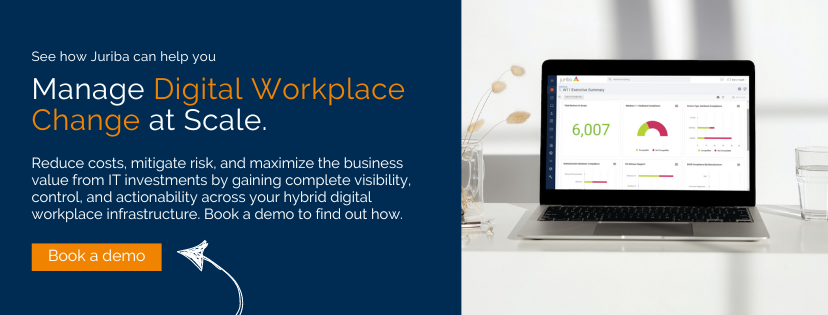What are Gartner's Digital Platform Conductor tools and why you do need one?
February 1st, 2023
3 min read
By Barry Angell

In April 2024, Gartner® published its latest Digital Platform Conductors (DPC) Market Guide. In this report, the analyst company explores a rapidly evolving technology market currently crystallizing out from various other tooling segments to meet the needs of Infrastructure & Operations (I&O) leaders who are struggling to deliver consistent business value across their increasingly complex on-premise, hybrid, and cloud environments.
By streamlining the automation and orchestration bits and pieces needed to manage such complex technology and infrastructure landscapes, DPC tooling allows enterprises to not only improve the health, performance, and resilience of such, but also finally unlock the full ROI potential of their technology investments.
While this is a new topic, Juriba has aligned itself with this Gartner category as it closely describes the competitive marketplace we operate in. In this article, I want to not only define the term Digital Platform Conductors (DPC), but also explain why organizations should explore DPC tooling.
What is a Digital Platform Conductor (DPC) tool?
Gartner® coined the term Digital Platform Conductor (DPC) in 2021. The analyst company defines it as follows:
“Digital Platform Conductor (DPC) tools coordinate Hybrid Digital Infrastructure Management (HDIM) tools used to plan, implement, operate, and monitor underpinning technology and services for applications and digital products. They may be delivered as on-premise, Software-as-a-Service (SaaS), or Platform-as-a-Service (PaaS) and provide a unified view of digital infrastructure and dependent applications.
They enable I&O leaders to get an overarching view of the infrastructure and evaluate the infrastructure's contribution to business value, regardless of the environments used or their owners. This provides input into strategic I&O decision-making to get better value from infrastructure.”
In other words, a Digital Platform Conductor provides I&O leaders with a:
- Coherent View: 360-degree, single-pane-of-glass view of their entire IT landscape, including on-premise, hybrid, and cloud environments,
- Workload Flow: A central command and control center coordinating various hybrid digital infrastructure management tools (e.g., SCCM, Intune, ServiceNow, Access IT Automation, etc.).
- Tangible Business Value: By finally being able to tie together all the loose ends, I&O leaders can better understand how certain pieces of technology or infrastructure contribute to the bottom line and make value-based business decisions.
As part of their report, Gartner maps out nine key capabilities that a Digital Platform Conductor should demonstrate. Keep in mind that no solution on the market has the full (or even close to complete) set of capabilities yet, as the term is so new:
- Workload Assignment (Where should application workloads be processed?)
- Service Enablement (single pane of glass for multiple connected HDIM tools)
- Value Monitoring & Observability (aggregate various data streams to estimate business value)
- Technology Inventory & Classification (inventory of all technology assets and their dependencies in change context)
- Cost Management & Resource Optimization (manage HDIM spending and resource allocation)
- Migration, Backup, & Disaster Recovery (data protection and management for business continuity and optimal application workload migrations)
- Identity, Security, & Compliance (cross-platform security and compliance insights and visibility)
- Packaging & Delivery (administration of the DPC and other HDIM tools)
- Value Improvement Visibility (measure, track, and monitor business impact)
As you can see, a Digital Platform Conductor does NOT set out to replace HDIM tooling, such as cloud management solutions. It creates a much-needed layer to manage insights, automation, and orchestration provided by other tools across different platforms.
Do you need a Digital Platform Conductor (DPC)?
Infrastructure & Operations (I&O) leaders are increasingly responsible for their organization's hybrid digital infrastructure that is spread over multiple on-premise, cloud, and edge environments. The pressure to cut costs and increase flexibility drives a "Cloud First" strategy. This, coupled with a distributed (partially remote or hybrid) user base and modern development approaches that don't conform to siloed IT management, such as DevOps, results in siloed, disparate, and overly complex IT landscapes. Instead of the desired IT agility, organizations struggle to grasp the impact any required change has on their environment — both in terms of business value and risk.
To gain back control, organizations have invested in many different Hybrid Digital Infrastructure Management (HDIM) point solutions, such as:
- IT Asset Management (ITAM), IT Infrastructure Monitoring (ITIM),
- Data Center Infrastructure Management (DCIM),
- Digital Experience Management (DEX),
- Software Asset Management (SAM),
- Cybersecurity Asset Management (CSAM),
- Cloud management, and
- Other related tools.
While they all contribute their part to the management of these complex IT landscapes, their data could be seen as individual musicians within an orchestra. Without a conductor, everyone playing at the same time creates an indistinguishable noise, but with a conductor, it all comes together beautifully and in harmony.
As a market, DPC is still very immature. In fact, Gartner placed DPCs in the 'embryonic stage' called "Innovation Trigger" in the 'Agile & DevOps,' 'I&O Automation,' 'ITSM,' and 'Monitoring, Observability, and Cloud Operations' hype cycles to recognize its early, yet powerful transformational force. It is expected that it will require another five to ten years to reach the "Plateau of Productivity," meaning full maturity. Examples of I&O platform-led DPC providers are Cloudsoft, Stonebranch, Flexera, and Readyworks. However, other examples come from a hyper-scale-, industry cloud-, and integrator-led angle.
Juriba: Digital Platform Conductor for the Workplace
Over the past few years, Juriba has positioned itself as the Workplace Automation platform of choice for large organizations worldwide. We know this messaging has been confusing because there wasn't a proper market category at the time. Thankfully, Gartner has recognized the market developments around this space called Digital Platform Conductor. Juriba aligns closely with the Digital Platform Conductor definition and provides a unique Workplace angle.
Over the next weeks and months, we will dive deeper into Juriba's new positioning and how it fits within the DPC definition, explore the benefits and challenges you can expect when adopting a DPC tool so early in its maturity cycle, outline the different options and solution approaches you can choose from now, and much more. In the meantime, I would love to hear from you. Have you encountered the DPC tool topic before? Is this something you might have already started to explore?
Barry is a co-founder of Juriba, where he works as CEO to drive the company strategy. He is an experienced End User Services executive that has helped manage thousands of users, computers, applications and mailboxes to their next IT platform. He has saved millions of dollars for internal departments and customers alike through product, project, process and service delivery efficiency.




%20Project%20Plan%20For%20Maximum%20Velocity%20Upgrades.jpg?width=1600&height=900&name=Introducing%20The%20New%20Windows-as-a-Service%20(WaaS)%20Project%20Plan%20For%20Maximum%20Velocity%20Upgrades.jpg)






